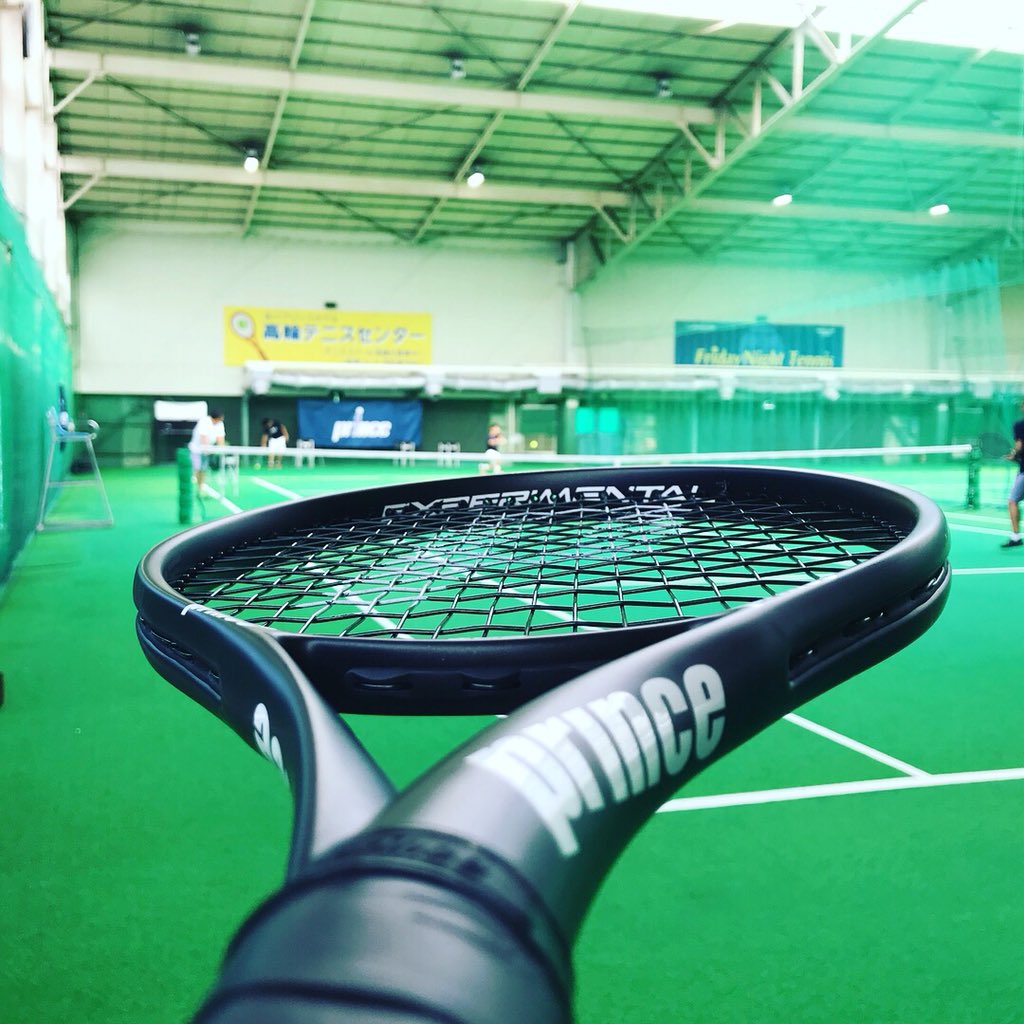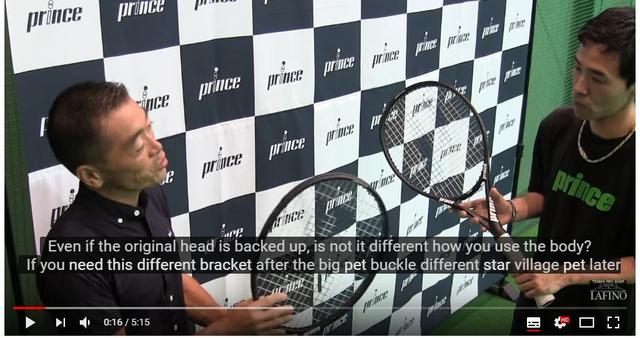You are using an out of date browser. It may not display this or other websites correctly.
You should upgrade or use an alternative browser.
You should upgrade or use an alternative browser.
Prince Japan..TWIST POWER TECHNOLOGY
- Thread starter PBODY99
- Start date
Frans Bleker
Professional
Who comes up with this...
Dartagnan64
G.O.A.T.
Who comes up with this...
One often wonders if marketing teams go to engineers and say, "Hey we need something that looks new and innovative. Doesn't actually have to do anything useful, but looks different. As long as it doesn't make the racket actually play too much worse, we can work with it and convince people they will be awesome with it."
Twist technology looks like an answer to a problem no one ever had. But it's different.
3loudboys
G.O.A.T.
Who comes up with this...
Chubby Checker originally....
Sent from my iPhone using Tapatalk
Nostradamus
Bionic Poster
WOW,, this is the miracle tech that will save Prince rackets and move them to #1 racket used in amateur tennis. this stuff works I heard. I only hope they make it with Low swing weight.Demos in are out in Japan
July 5: Takanawa Tennis Center
July 8th to the Mori tennis center in Showa
Will it see the light of day in the USA ?

PBODY99
Legend
Pro Kennex in 1992 released the Asymmetric 265, with the hoop providing the difference.
It was based on the Destiny mold
https://www.nytimes.com/1992/06/20/news/a-racquet-with-precision-in-mind.html
From what I could gather the twisted shaft is supposed to do something similar.
It was based on the Destiny mold
https://www.nytimes.com/1992/06/20/news/a-racquet-with-precision-in-mind.html
From what I could gather the twisted shaft is supposed to do something similar.
DanS
Semi-Pro
I had this posted in another thread:
https://tt.tennis-warehouse.com/index.php?threads/prince-2018.617952/#post-12327900
Here are some pics too:


https://tt.tennis-warehouse.com/index.php?threads/prince-2018.617952/#post-12327900
Here are some pics too:


I want a racquet that looks like this:
http://www.mcescher.com/gallery/recognition-success/knots/
http://www.mcescher.com/gallery/recognition-success/knots/
I like it. Just wish the colour scheme is a bit more bold
Sent from my iPhone using Tapatalk
Black works for me every time.
Zoolander
Hall of Fame
Im intrigued. I want to hit with it.
We really need to pay someone to translate Fukkys videos for us. I put this one on autotranslate in youtube and this is what I got......

WTH???
I had this posted in another thread:
https://tt.tennis-warehouse.com/index.php?threads/prince-2018.617952/#post-12327900
Here are some pics too:


We really need to pay someone to translate Fukkys videos for us. I put this one on autotranslate in youtube and this is what I got......

WTH???
DanS
Semi-Pro
Im intrigued. I want to hit with it.
We really need to pay someone to translate Fukkys videos for us. I put this one on autotranslate in youtube and this is what I got......

WTH???
Someone needs to translate the translation! LMAO
This is what you get when you combine Möbius strip with racquet design.
Imago
Hall of Fame
How do Japanese communicate with each other?!
Sanglier
Professional
I don't speak or read Japanese, but my guess is that this beam geometry is meant to create a gradual decrease in stiffness from the head (stiff) to the grip (flexible), without resorting to complicated (and externally invisible) changes in layup composition and/or prepreg orientation. If so, it would be the same idea behind Yonex's Oval Pressed Shaft (O.P.S.) YY7500 and YY8500 from the 1970s. I would be honestly shocked if there is anything more high-tech than this lurking beneath what meets the eye.
The asymmetrical designs from PK and Rossignol on the other hand were meant to create different vibration frequencies on the two shafts, which were supposed to interfere with each other as they reach the grip, reducing felt shock (same principle as those noise-canceling head phones); so they are probably not directly comparable to this.
The asymmetrical designs from PK and Rossignol on the other hand were meant to create different vibration frequencies on the two shafts, which were supposed to interfere with each other as they reach the grip, reducing felt shock (same principle as those noise-canceling head phones); so they are probably not directly comparable to this.
Tommy Haas
Hall of Fame
The patents finally expired, so Prince saw a "new" fangled tech to reintroduce to market. It was either they do it or Head would.
PBODY99
Legend
Two models 100 & 105. Right handed & left handed versions.
https://princetennis.jp/archives/column/column_prince_x
I used Chrome to translate the page
https://princetennis.jp/archives/column/column_prince_x
I used Chrome to translate the page
Sanglier
Professional
I think I know what they are saying in that text, but I still don't quite get it.
They are asserting that the "twist" increases the power of the backhand without adversely affecting the forehand, thanks to the shaft geometry difference on the two sides.
Unless there is a designated 'front' side and a 'back' side on these racquets (like on the tilted-head and bent-grip racquets), how is this difference achieved?
From their illustrations (in both the righty and lefty iterations), all I can see is that when the racquet is held in a conventional grip, the upper shaft connects to the grip on the palm side (in front), while the lower shaft connects to the grip on the knuckle side (at the back). During a forehand stroke, it's the upper shaft that is closest to the ball where it connects to the grip. During a backhand stroke, it's the lower shaft that faces the ball. Why would this have any differential effect on power generation?
If one shaft has a different flex characteristic as the other shaft, and the racquet behaves differently depending on which shaft is connected to the grip on the palm side (in front) and which is on the knuckle side (behind), then rotating the racquet in one's hand would flip the flex characteristics, regardless of whether one is hitting a forehand or backhand.
Or am I missing something obvious?
They are asserting that the "twist" increases the power of the backhand without adversely affecting the forehand, thanks to the shaft geometry difference on the two sides.
Unless there is a designated 'front' side and a 'back' side on these racquets (like on the tilted-head and bent-grip racquets), how is this difference achieved?
From their illustrations (in both the righty and lefty iterations), all I can see is that when the racquet is held in a conventional grip, the upper shaft connects to the grip on the palm side (in front), while the lower shaft connects to the grip on the knuckle side (at the back). During a forehand stroke, it's the upper shaft that is closest to the ball where it connects to the grip. During a backhand stroke, it's the lower shaft that faces the ball. Why would this have any differential effect on power generation?
If one shaft has a different flex characteristic as the other shaft, and the racquet behaves differently depending on which shaft is connected to the grip on the palm side (in front) and which is on the knuckle side (behind), then rotating the racquet in one's hand would flip the flex characteristics, regardless of whether one is hitting a forehand or backhand.
Or am I missing something obvious?
Last edited:
Sanglier
Professional
@Sanglier
Perhaps it is the alinement of the shafts when striking the ball,otherwise why have lefty v righty versions.
This is precisely what they are claiming, but I've been trying to understand the 'how' part.
They are essentially saying that this racquet behaves differently depending on the direction in which it is swung relative to how it's held, even if you are using the same surface to strike the ball, and they claim to have achieved this through the twist geometry alone (without engineering a permanent distinction between a 'forehand' strike surface and a 'backhand' strike surface). This is a completely novel idea as far as I know; which may require some creative syntax to describe clearly (thus explaining why the translation from Japanese is so confounding, and why my own attempt at articulating it isn't any better). It could be one of those things that are easier to see and to feel than to verbalize?
So far at least, regardless of how I play it out in my head, I still don't get how this intriguing idea is supposed to help generate better backhands, even at the conceptual level. My own backhand is atrocious, so my interest is more than academic in this case.
Last edited:
loosegroove
Hall of Fame
Two models 100 & 105. Right handed & left handed versions.
https://princetennis.jp/archives/column/column_prince_x
I used Chrome to translate the page
Where are you seeing right and left handed versions?
PBODY99
Legend
I'm going to have to be a doubting Thomas on this one. Not until I hit with it and experience some sort of difference depending on how I'm holding it will I believe that this tech is worth .10¢.
I have a theory about how it could work, but I feel like if that's they way it works it will also be asymmetrically stable in the hoop, which is not something I would want.
Having said all that I would love to hear from people who actually get to hit with one what they think of it.
I have a theory about how it could work, but I feel like if that's they way it works it will also be asymmetrically stable in the hoop, which is not something I would want.
Having said all that I would love to hear from people who actually get to hit with one what they think of it.
Zoolander
Hall of Fame
Been trying to study photos to see exactly how the throat differs, one side to the other. The fact that there is two "versions" as @Sanglier said, with a front and back side to each and that the power level is apparently 10% higher one side means it obviously does. Hard to tell from photos how the throat design changes on each side...... they could change the layup each side to make one side stronger in compression than the other, increasing stiffness on one side and thus power?
loosegroove
Hall of Fame
Been trying to study photos to see exactly how the throat differs, one side to the other. The fact that there is two "versions" as @Sanglier said, with a front and back side to each and that the power level is apparently 10% higher one side means it obviously does. Hard to tell from photos how the throat design changes on each side...... they could change the layup each side to make one side stronger in compression than the other, increasing stiffness on one side and thus power?
On the forehand side, the shafts of the throat are twisting down. On the backhand side, the shafts of the throat are twisting up. How that change in geometry changes the frames response, I have no idea. So it would be interesting if you could get identical frames in lefty and righty versions and really assess if there's a difference.
Similar threads
- Replies
- 16
- Views
- 2K



